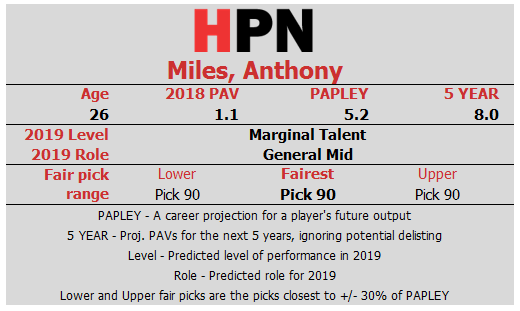Possibly as a goodwill gesture in return for securing Tom Lynch as a free agent signing, Richmond have traded two of their fringe players to the Suns. Due to lack of senior gametime they both project quite lowly in terms of expected future Player Approximate Value:

The trade as carried out by the Tigers and Suns basically rates Ellis and Miles as together worth the difference in next year’s picks, which isn’t something our projections disagree with too much. We value future picks at this year’s ladder positions, and the gap there (3rd and 17th) can’t get much bigger than it is already:
There’s an enormous caveat here: while our projections are based on exposed senior output, we have good reason to think Miles, a 26 year old midfielder, is a lot better than a fringe player likely to wash out.
Sorting our 2018 Player Approximate Value data by mPAV (marginal, per game PAV) shows that in his one game in 2018 he ranks third in the league. It was a valuable game he played! With Martin missing against Port Adelaide in round 12, Miles played a similar goal-kicking, inside-50 supplying, clearance-winning midfield role and didn’t actually do a whole lot worse than Dusty himself in those terms.
That’s a tiny sample size and probably unsustainable, sure, but we can also look at a pretty solid five game stretch last year. In 2017 Miles was around a middle-of-the-league mPAV (-0.06), with a gross PAV of 2.6. His 2017 mPAV was good enough for roughly 10th best at the Suns in 2018, a list which includes at least two players who won’t be there in 2019:
This is before we consider that Miles topped 13.4 PAV in 2016 and 20.2 (!) in 2015. For those playing at home, 20.2 PAVs in a season is elite – but an extreme outlier for Miles’ career to date.
All this makes Miles a prime candidate to be one of those players who couldn’t fit into a top side, but who will be successful in a weaker side where he’s clearly going to be best 22. Gold Coast has some success with Witts and Lyons – players who fall into the same category – recently.
With regards to Ellis, there’s nothing to suggest a similar upside, but as a 22 year old notional small defender is much closer to a blank slate for the Suns.
Verdict: Fair trade, but with very high potential upside on Miles for the Suns
Tom Lynch free agency addendum
If we assume this trade was part of a tacit agreement linked to Tom Lynch moving to Gold Coast as a free agent, the overall exchange looks rather different. As we discussed last week, the shorter shelf life of free agents in general, plus a shaky recent period of form and injury for Tom Lynch specifically, both mean the career yield of pick 3 is projected to be a lot higher than Lynch’s future value.
Even doubling Lynch’s projection so it better aligns with his peak years still isn’t likely to give him as much output as pick 3 will have over its average career. The injection of the compensation pick therefore turns the Tigers and Suns’ exchange into a major win-win.
 Pick 3 comes at the expense of every other club’s draft position, but Richmond didn’t give anything up, so the exchange becomes asymmetrical, unlike trades which are necessarily calculated as zero-sum. (Note that we didn’t calculate the relatively small effect of the two clubs’ later selections sliding by 1 spot.)
Pick 3 comes at the expense of every other club’s draft position, but Richmond didn’t give anything up, so the exchange becomes asymmetrical, unlike trades which are necessarily calculated as zero-sum. (Note that we didn’t calculate the relatively small effect of the two clubs’ later selections sliding by 1 spot.)
Gold Coast win big. They get pick 3, the output of which projects better than Lynch’s remaining career, and would still do so even if the soon to be 26 year old Lynch is assumed to have much better form and longevity than being projected here. In addition, they get the two players who both may play useful roles as discussed above.
For Richmond, Tom Lynch, even with our bearish projection, more than balances out the loss of the fringe players Ellis and Miles. Even though he probably gives less than pick 3 will in total, the Tigers were never getting pick 3, and they’ll be most interested in the immediate payoff of making their side better in the next couple of years.
Note: This post is part of a series of posts using a valuation method called Player Approximate Value (PAV) to evaluate trades for fairness and balance. Elsewhere, you can read much more about the method and theory behind PAV and also about PAPLEY, the projection method used to derive expected future PAVs. This method expresses both picks and players in terms of expected future value allowing them to be compared on this common basis.





